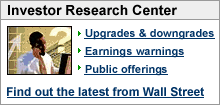Fed officials to Wall St.: not so fastComments on Monday seek to cool hopes for a big rate cut. But will a smaller cut be enough to soothe investors?NEW YORK (CNNMoney.com) -- Friday's weak August payrolls report raised bets that the Federal Reserve could cut interest rates by a half-percentage point when it meets next week. On Monday, a barrage of Fed speakers sought to disabuse investors of that notion. Stocks didn't react much, and the major gauges ended little changed on Monday. But the reaction could be more dire next Tuesday, depending on the outcome of the policy meeting. Amid the housing market turmoil, a rise in mortgage defaults and tighter credit, investors have been looking for at least a quarter-percentage point cut at the Sept. 18 meeting - and perhaps some moderately weak economic news to justify a cut. (For details, click here.) But Friday's jobs report threw investors for a loop, showing a drop in monthly payrolls for the first time in four years, when investors expected a rise. The reports sparked worries that sluggish employment will hurt consumer spending and by extension, the economy. Following that report, investors began to price in a half-percentage point cut. Not so fast, was what comments by several Fed officials seemed to be saying on Monday. If the Fed only cuts interest rates by a quarter-percentage point, the financial markets will show some disappointment, said Gregory Miller, chief economist at SunTrust Banks. But if they don't cut rates at all, "I think the market has bought itself a bigger disappointment," he said. "The market has priced Fed easing in, but that doesn't mean the Fed is obligated to do that," Miller said. San Francisco Fed President Janet Yellen said that while market turmoil could threaten the economy, it's not the Fed's job to bail out investors. Fed chairman Ben Bernanke made similar comments at an economic symposium last week. Atlanta Fed president Dennis Lockhart said that the central bank takes the weak jobs report seriously, but the report is outdated and should be considered along with recent signs of solid retail sales and still-strong consumer spending. Over the weekend, Fed president Charles Plosser acknowledged the weak August jobs report, but said it was not reason alone to cut interest rates. Yellen and Lockhart aren't voting members of the Fed's policy committee this year, and Plosser is an alternate member, also non-voting. Fed Governor Frederic Mishkin, who is a voting member of the policy committee, speaks later Monday and Bernanke speaks Tuesday. Yellen's comments in particular could be taken as indicating that there is a possibility of only a quarter-percentage point cut next week, said Keith Hembre, chief economist at First American Funds. However, he doesn't think that's likely. "Futures are priced for a 50 basis point cut as of Tuesday and if the Fed only does 25, they are going to disappoint the markets," Hembre said. "It becomes counterproductive of them to only do 25 at this point." There are 100 basis points in one percentage point. More likely, the speeches Monday indicate that there is a bit of a divide among the policy makers themselves as to what to do next week, Hembre said. The fed funds rate, a key short-term interest rate that impacts consumer loans, has stood at 5.25 percent since June 2006, as the central bank has sought to balance a slower growing economy with inflationary pressures amid higher commodity prices and a booming world economy. But lately, the economic growth has slowed amid the collapse of the housing market, the subprime mortgage mess and the seeming end of a period of freer-flowing credit. All of which has sent financial markets into turmoil and has raised bets that the central bank will cut interest rates shortly. When this might happen and by how much has been in question. Fed officials initially sought to downplay the impact of the credit and mortgage crisis on the broader economy, particularly in the statement released after the last Fed meeting on Aug. 7. But just ten days later, on Aug. 17, the Fed cut the discount rate - which impacts bank loans - by a half-percentage point. The bankers also issued a statement acknowledging the market instability, the credit and mortgage woes and the risk of economic growth weakening as a result. Stock investors took this to mean the Fed will cut rates at the next meeting on Sept. 18, by either 25 basis points or 50 basis point. Over the last few weeks, Fed officials have made statements indicating that, yes, they are closely watching the market churning, but they are not necessarily going to cut rates as a result, particularly as it could serve to drive up pricing pressures. Simultaneously, the Fed has injected billions into the banking system to keep the liquidity flowing. "The Fed doesn't want to be seen as just responding to market worries," said Ryan Atkinson, vice president and market analyst at Balestra Capital. "But also, the last thing they want to do is allow the real economy to deteriorate." Friday's jobs report sparked a big stock decline, with the Dow losing 250 points, as investors worried that maybe the Fed was behind the curve. If nothing else, Monday's comments from the Fed officials seemed to soothe worries that the Fed has waited too long to step in. If the Fed wants to stay ahead of the curve, a 25-basis point reduction would be a way to help them calm markets, without risking the outlook for inflation, Miller said. |
|





